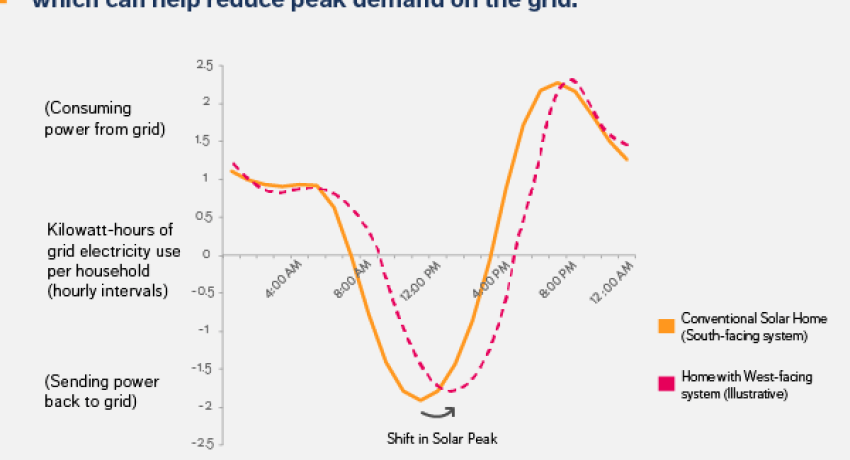West side is the best side for solar
The west side is the best side of the roof for solar panels, according to new data analysis from Opower, which specializes in cloud-based software for the utility industry.
Opower released a detailed analysis this week of all its data on home energy use and solar panel orientation. Opower has information on more than 50 million households worldwide. Using that and public data on about 110,000 residential solar projects in California, Opower confirmed what another team of researchers found from a study of just 50 homes in Texas last year.
West-facing rooftop solar makes more sense than south-facing panels in our modern world.
While they generate 10 to 20 percent less electricity a year, they produce the most power when it’s most needed during the day.
“Solar homes are mini power plants,” reads the Opower blog, “but most of them are out of step with the grid.”
Homes outfitted with south-facing solar panels produce the most energy between 11 a.m. and 1 p.m. In the example Opower cites from May 14, 2014, one solar home produced enough excess electricity to power two non-solar homes during that period.
The utility credits solar homeowners for their overproduction of power through net metering, which is available at varying levels in 40 states. The solar owner then effectively pays for the grid power he uses after the sun sets with that credit.
If solar panels face west instead of south, they would generate the most energy as the sun is setting in the early afternoon hours when energy demand peaks, according to Opower’s analysis.
Peak production for west-facing panels is at 2 p.m. rather than noon and the panels continue to generate significant amounts of electricity until well past 4 p.m.
Energy demand spikes at that time because businesses are still up and running as people return home from school and work to switch on their own appliances.
Only about 9 percent of solar homes orient their panels to the west. Since net metering policies reward homeowners for total generation, it will be difficult to convince anyone to switch without incentivizing it somehow.
Opower suggests that utilities might offer a premium buy-back rate for power produced during peak periods.
California initiated a $500 additional rebate in September for anyone who installed a west-facing system.
Arizona Public Service, which has become notorious for attempting to implement new fees and taxes on rooftop solar in an effort to protect its monopoly on electricity generation, recently proposed a new plan that would incentivize west-facing panels by punishing homeowners who install south-facing systems.
The utility, which has faced some pretty heavy allegations of trying to kill competition from distributed solar in an effort to protect its own profit margins, is now proposing a $50 per month fee on new solar installations unless the owners can increase production and reduce their use during peak demand hours.
The proposal, if it passes, would be damaging to Arizona’s growing solar industry.
Some forward-looking theorists speculate the plan could backfire on the utility in the long run. As it will encourage investment in energy storage technology, APS could see more homeowners interested in going solar disconnect from the grid altogether rather than roll the dice with a hostile utility company for grid access. Of course, it will be at least a couple years before battery storage makes economic sense and the proposed policy would likely slow solar installations in the state for that period.




